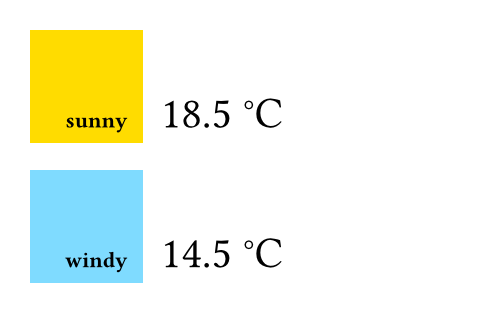翻訳済み
このページは日本語に翻訳済みです。
json
JSONファイルから構造化データを読み込む。
読み込むファイルにはオブジェクトや配列などの有効なJSON値が含まれていなければなりません。
JSONオブジェクトはTypstの辞書に変換され、
JSON配列はTypstの配列に変換されます。
文字列やブール値はTypstの対応する型に変換され、nullはnoneに、
数値は整数値であれば整数型に、
そうでなければ浮動小数点数型に変換されます。
263-1より大きな整数は浮動小数点数に変換されるため、 近似値になる可能性があることに留意してください。
この関数は、辞書、配列、 あるいはJSONファイルの内容に応じてその他のJSONデータ型を返します。
この例におけるJSONファイルは、
temperature、unit、およびweatherというキーを持つオブジェクトを含んでいます。
例
#let forecast(day) = block[
#box(square(
width: 2cm,
inset: 8pt,
fill: if day.weather == "sunny" {
yellow
} else {
aqua
},
align(
bottom + right,
strong(day.weather),
),
))
#h(6pt)
#set text(22pt, baseline: -8pt)
#day.temperature °#day.unit
]
#forecast(json("monday.json"))
#forecast(json("tuesday.json"))

引数引数引数は関数への入力値です。関数名の後に括弧で囲んで指定します。
引数
引数は関数への入力値です。関数名の後に括弧で囲んで指定します。
json()->any定義定義これらの関数や型には、関連する定義を持たせることができます。定義にアクセスするには、対象の関数や型の名前を指定した後に、ピリオド区切りで定義名を記述します。
定義
これらの関数や型には、関連する定義を持たせることができます。定義にアクセスするには、対象の関数や型の名前を指定した後に、ピリオド区切りで定義名を記述します。
decode
decode`json.decode`は非推奨です。代わりにバイト列を直接`json`に渡してください。
JSONの文字列やバイト列から構造化データを読み込む。
json.decode()->any